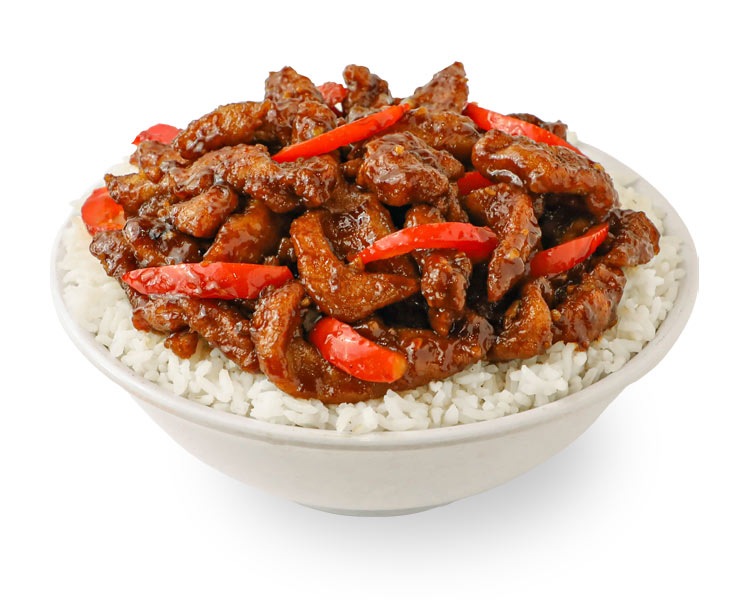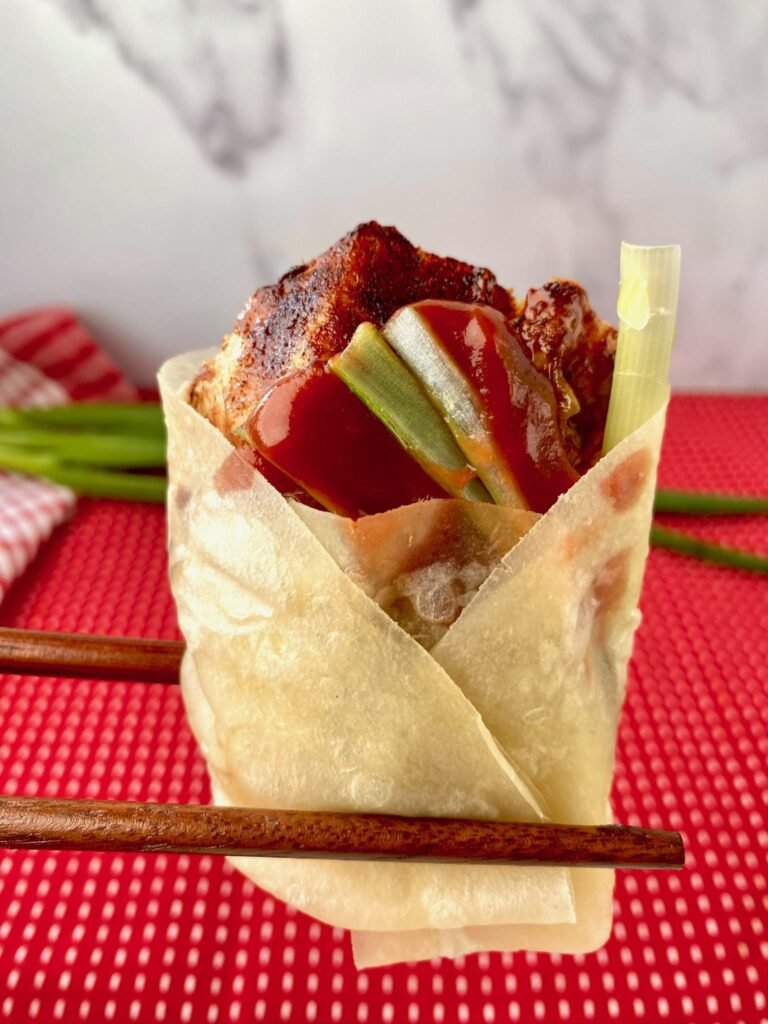Peking Duck Pancakes are one of my favorite things to enjoy eating. Whether at home or at a good Chinese restaurant, they’re a delicacy that is so indulgent. This recipe emulates all those wonderful flavors and textures of the famous dish but replaces Duck with Chicken Breast. We’re proud to say that this Peking Chicken recipe using skin-on Chicken Breast is an awesome version of the original, and given it uses Chicken, is a lot more adaptable and accessible than the Duck version.
Peking chicken is a tasty Chinese dish made by roasting chicken until it is golden brown and crispy. This article will teach you everything you need to know to make and enjoy authentic Peking chicken. It is based on the more complicated Peking duck, but is prepared in a way that is easier to do at home.
At its core, Peking chicken consists of tender roasted chicken meat coated with a sweet glaze and served alongside thin pancakes, scallions, cucumbers, and hoisin sauce. It originated as a more approachable adaptation of Peking duck, which requires extensive drying and inflating of the duck skin during preparation. Peking chicken simplifies this process while still emulating the flavors and textures of the duck version.
The key characteristics of great Peking chicken include:
- Crispy, lacquered skin
- Succulent, flavored meat
- Sweet hoisin glaze
- Refreshing veggie accompaniments
- Thin Chinese-style pancakes
When assembled together, these components create a harmonious balance of flavors and textures for a truly satisfying culinary experience.
Difference Between Peking Chicken and Peking Duck
While Peking chicken draws inspiration from Peking duck, there are some important differences:
-
Preparation – Peking duck requires multiple days to dry the skin and uses extensive inflating techniques. Peking chicken focuses on brining, marinating, and roasting.
-
Complexity – Peking duck is very labor intensive. Peking chicken is much simpler to make at home.
-
Cost – Peking duck is more expensive and uses specialty ingredients. Peking chicken uses easy-to-find ingredients.
-
Flavor – Duck has a richer, gamier taste. Chicken is milder and benefits from bold seasoning.
-
Fat Content – Duck has a thick layer of fat. Chicken is leaner with less fat to render.
History and Origins
Peking duck has a long imperial history in Beijing dating back centuries. Peking chicken is a more recent adaptation that likely emerged in the 20th century as a simpler option for less specialized restaurants. It was created to allow more home cooks and restaurants to serve dishes that captured the essence of Peking duck without the difficult preparation. Over time, Peking chicken has evolved into a distinct dish in its own right rather than just a substitute.
How to Make Peking Chicken at Home
Making restaurant-quality Peking chicken is achievable at home with the right techniques:
Pick a good chicken. You can use a whole chicken or chicken breasts or thighs with the skin still on. Free-range and organic birds have better flavor.
Dry the skin – Pat skin dry and let air-dry uncovered in the fridge overnight to dehydrate the skin. Salt and baking powder also help draw out moisture.
Marinate – Soak chicken in a marinade of soy sauce, Shaoxing wine, ginger, and spices overnight.
Roast on high and low heat. Bring the chicken to 450°F to get the skin crispy, then lower the heat to 350°F to finish cooking it.
Brush glaze – Coat chicken with a glaze of hoisin, honey, and five-spice when internal temp reaches 120°F.
Rest before slicing – Let chicken rest at least 15 minutes before slicing to allow juices to redistribute.
Slice and assemble – Slice chicken and serve with pancakes, hoisin, cucumbers, and scallions.
Key Components of Peking Chicken
The Chicken
- Skin-on chicken thighs or breast are ideal
- Dark meat holds up better to high heat
- Skin must be dried out thoroughly pre-roasting
- Marinade adds flavor and tenderizes
- Two-stage roasting method ensures juicy meat and crispy skin
The Glaze
- Typically hoisin sauce, honey, and five-spice powder
- Brushed on midway through roasting
- Helps crisp skin and adds flavor
- Causes lacquered, caramelized exterior
Accompaniments
- Thin Chinese pancakes or tortillas
- Julienned scallions and cucumbers
- Hoisin sauce for extra glazing
- Refreshing contrast to rich chicken
- Assembled by diners themselves
Serving and Eating Peking Chicken
Peking chicken is highly interactive dining experience centered around DIY assembly:
- Chicken is sliced tableside to showcase crispy skin
- Diners place chicken slices, scallions, and cucumbers on a pancake
- Hoisin sauce is drizzled on top as desired
- Pancake is rolled up and eaten by hand
This hands-on process allows diners to customize each bite and experience an array of flavors and textures in one dish. The crispy chicken skin provides crunch, the hoisin lends sweetness, the veggies offer brightness and crunch, and the soft pancake ties it all together.
Frequently Asked Questions
What’s the best chicken cut to use? Whole chicken or bone-in thighs/breasts work well. Skin-on is essential.
Can I skip drying the skin? You can, but the skin won’t be as crispy. At least pat it dry and salt generously.
What if I can’t find Shaoxing wine? Dry sherry makes a suitable substitute.
How long should I marinate the chicken? At least 4 hours, but overnight is best for flavor penetration.
What temp and time to roast chicken? Start at 450°F for 15 minutes then reduce to 350°F until 155°F internal temp.
Can I prep chicken ahead of time? You can marinate 1-2 days in advance. Don’t roast until ready to serve.
What sides go well with it? Steamed rice, sauteed bok choy, egg rolls, and soup.
Conclusion

How to get Crispy Chicken Skin
We oven roast the Chicken for this recipe for a few reasons. We need to alternate the heat during the cooking process, which is much easier to manage in the Oven. Secondly, we apply a delicious glaze to the Chicken about 10 minutes before it is done. The glaze gives the chicken it’s beautiful dark caramel color and wonderful flavor.
To begin cooking the Peking Chicken, crank your oven to the highest temperature it can go. Anywhere between 450F – 500F is where you want to be. As soon as the oven is hot, put the chicken on a sheet pan in the middle of it.
The high temperature will begin to immediately cook the outside of the Chicken. You’ll notice about 5 – 10 minutes that the Chicken skin will start to bubble and already crisp up in places. This is what we want!.
At this point, drop the heat down to a more moderate temperature, around 350F and slow roast the Chicken for the rest of the cook. We recommend checking on the Chicken temperature periodically, because once its internal temperature reaches 120F, it’s time to apply the Glaze.

What is Peking Chicken?
Simply put, we are replicating the elements of Peking Duck, but using Chicken instead of Duck. The dish consists of perfectly cooked Chicken which comes completes with a lovely, crispy skin. Thin Chinese style Pancakes that the duck is wrapped up in. Finally, the addition of Scallions and Hoisin Sauce complete the dish.
The Chicken is sliced into individual portions, ensuring each bite has an adequate amount of crispy skin (which is the best part!). It’s placed on top of the unwrapped pancake. Toppings of Scallions and a generous amount of Hoisin Sauce is added and then it’s all wrapped up.
The ‘correct’ way to enjoy eating Peking Duck is to pick up the pancake parcel with Chopsticks and delicately eat it in small bites. Now, that may be all well and good for some, but for me – I like to dive right in with both hands. I’ll eat the thing like I’m devouring a Burger, and one to two bites is enough. But again, that’s just me!.

